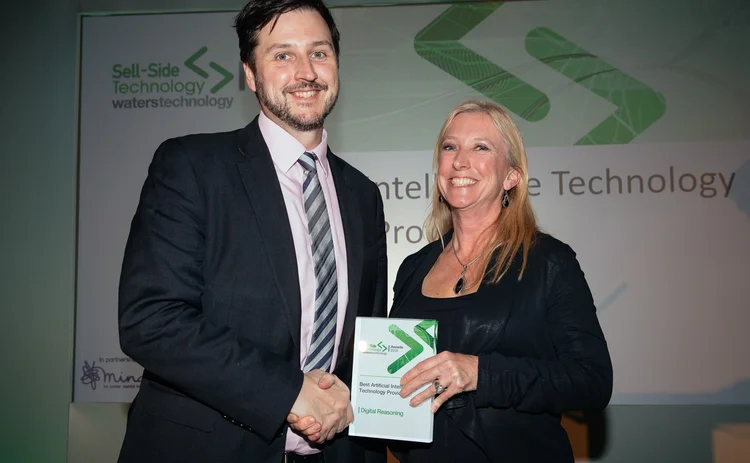SST Awards 2018: Best AI Technology—Digital Reasoning

The best artificial intelligence (AI) technology category has been around for two years, and in both instances it is Digital Reasoning that has taken home the top honor. Digital Reasoning’s Synthesys platform incorporates AI—from natural-language processing to deep-learning algorithms—to derive actionable information for risk and compliance, to monitor for fraud, and to provide customer insights.
The platform “learns” human communication, in textual form, audio and through images. It sifts through vast quantities of unstructured data—across multiple languages and domains—to derive intent and human behavior, says Tim Estes, president and founder of Digital Reasoning. “It completes the picture of looking at textual language, audio language, and starting to have a full communications capability to satisfy both risk and revenue-oriented use-cases,” he says. “We think that’s Digital Reasoning’s primary differentiation: We think that understanding people begins with understanding what they want and what they say—everything else is metadata, and that’s commoditized. So when we look at understanding people, we think it has to be about understanding intents and behaviors.”
In March, the vendor raised $30 million in a new funding round, led by BNP Paribas, but which also included Barclays, Goldman Sachs, Nasdaq, Square Capital, Lemhi Ventures, HCA, and the Partnership Fund for New York City. Digital Reasoning is used by financial services firms, as well as by US defense and intelligence agencies, and healthcare providers to diagnose disease.
Banks use Synthesys to identify customer complaints, find cross-sell and up-sell opportunities, to improve their know-your-customer (KYC) and anti-money laundering (AML) processes, and to meet regulatory demands stemming from Dodd–Frank, the revised Markets in Financial Instruments Directive (Mifid II) and the Market Abuse Regulation (MAR), and to oversee the entire trade lifecycle and provide an analysis of trade intent.
The platform is also being deployed to help firms adhere to the General Data Protection Regulation (GDPR), which went live as this magazine went to press. “It’s relatively easy to say someone has a strong relationship with someone else because of the amount of times they call each other, but what they say—looking at personal compared to business—is interesting. And there are ways to characterize conversations and classify them and categorize them without giving up the content. So in the GDPR world, which we’re moving into, it’s important to know the difference between a personal communication and a professional one,” Estes says.
Only users who have a paid subscription or are part of a corporate subscription are able to print or copy content.
To access these options, along with all other subscription benefits, please contact info@waterstechnology.com or view our subscription options here: https://subscriptions.waterstechnology.com/subscribe
You are currently unable to print this content. Please contact info@waterstechnology.com to find out more.
You are currently unable to copy this content. Please contact info@waterstechnology.com to find out more.
Copyright Infopro Digital Limited. All rights reserved.
As outlined in our terms and conditions, https://www.infopro-digital.com/terms-and-conditions/subscriptions/ (point 2.4), printing is limited to a single copy.
If you would like to purchase additional rights please email info@waterstechnology.com
Copyright Infopro Digital Limited. All rights reserved.
You may share this content using our article tools. As outlined in our terms and conditions, https://www.infopro-digital.com/terms-and-conditions/subscriptions/ (clause 2.4), an Authorised User may only make one copy of the materials for their own personal use. You must also comply with the restrictions in clause 2.5.
If you would like to purchase additional rights please email info@waterstechnology.com
More on Awards & Rankings
American Financial Technology Awards 2025 winner’s interview: Connamara Technologies
Connamara Technologies’ recent win in the AFTAs on the back of its EP3 platform
AFTAs 2025: Best data provider—Allvue Systems
Product: Private Credit Intelligence
AFTAs 2025: Best IT team—TCW Group
Team: TCW Group’s Investment Technology Team; Project: Engineering Solutions—ABF and insurance launches during Aladdin stabilization
Buy-Side Technology Awards 2025 winner’s interview: 73 Strings
73 Strings’ win in the BST Awards 2025 Best middle-office platform category
AFTAs 2025: Most cutting-edge IT initiative—J.P. Morgan
Project: Vida Beta One
Buy-Side Technology Awards 2025 winner’s interview: S&P Global Market Intelligence
S&P Global Market Intelligence’s success in the first year the Best private markets data provider category has been on offer.





